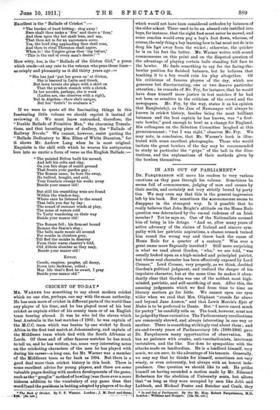CRICKET OF TODAY.* "MR. WARNER has something to say about
modern cricket which no one else, perhaps, can say with the same authority. He has seen more of cricket in different parts of the world than any player of his time, and he has played most of his beat cricket as captain either of his county team or of an English team touring abroad. It was he who led the eleven which beat Australia in the test matches cf 1903; be was captain of the M.C.C. team which was beaten by one wicket by South Africa in the first test match at Johannesburg, and captain of the Middlesex team which tied with the South Africans at Lords. Of these and of other famous matches he has much to tell us, and he has written, too, some very interesting notes on the cricketing characters of the men he has played with during his career—a long one, for Mr. Warner was a member of the Middlesex team as far back as 1894. But there is a good deal more than cricket history in this book. There is some excellent advice for young players, and there are some valuable pages dealing with modern developments of the game, such as the" googlie " method of bowling (was there ever a more hideous addition to the vocabulary of any game than that wordfland the positions in batting adopted by players of to-day • The Book of °Ticket. By P. F. Warner. London : J. M. Dent and f3ens,, • 144. [Ss. net. J • which would not have been considered orthodox by batsmen of the older school. There used to be an absurd rule instilled into boys, for instance, that the right foot must never be moved, and some coaches would even peg a boy's foot down, whereas, of course, the only thing a boy learning how to bat must not do is to drag his foot away from the wicket ; otherwise, the quicker he is on his feet the better. Mr. Warner writes with sound commonsense on this point and on the disputed question of the advantage of playing certain balls standing full face to the bowler. He finds something to say for the facing-the- bowler position for finished batsmen, but he believes that teaching it to a boy would ruin his play altogether. Of his criticisms of famous players of the day, which are generous but discriminating, one or two deserve particular attention ; he remarks of Mr. Fry, for instance, that he would have done himself more justice in test matches if he had not been so sensitive to the criticism of the crowd and the newspapers. Mr. Fry, by the way, states it as his opinion that Ranjitsinhji, as the Jam of Nawanagar will always be known in cricket history, besides being the most brilliant batsman and the best captain he has known, was "a first- rate bowler," good enough to bowl as a change for England. His colleagues on the Selection Committee laughed at this pronouncement ; "but I was right," observes Mr. Fry. We may note, in conclusion, that Mr. Warner's book is illus- trated with some excellent photographs. Those who would imitate the great bowlers of the day may be recommended to study in particular the " grips " of the ball in the illus- trations, and the explanations of their methods given by the bowlers themselves.










































 Previous page
Previous page